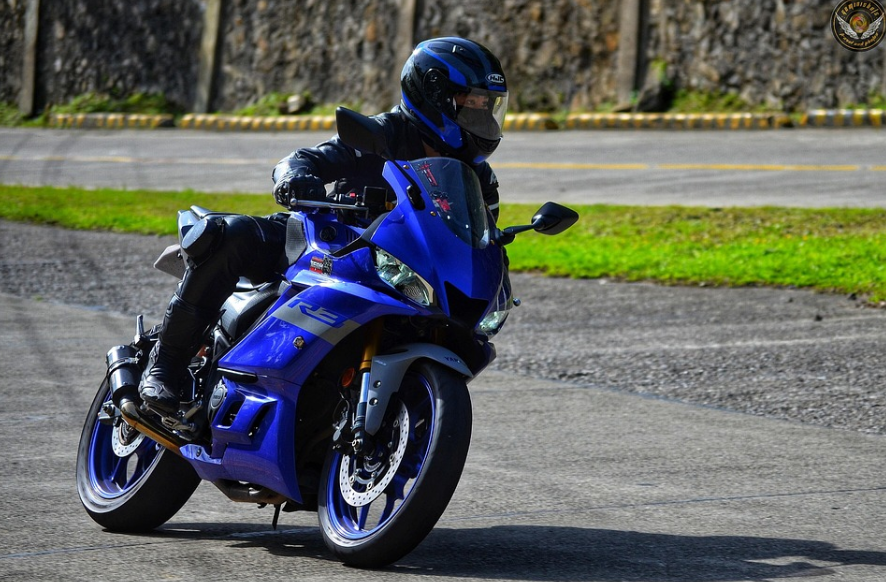When a day brings strong winds, overtaking a motorcyclist becomes significantly more risky. You need to allow extra room when overtaking a motorcyclist on a windy day. That extra room gives the rider crucial space to compensate for wind gusts and keeps both parties safer. This post explores Why Should You Allow Extra Room While Overtaking a Motorcyclist on a Windy Day?, explains how gusts impact riders, and delivers clear steps to overtake safely during crosswinds.
UK overtaking and rider‑safety resources often overlook wind‑specific overtaking guidance: how gusts funnel on bridges, how turbulence from other vehicles impacts rider path, and how sequential gusts increase drift risk. This article addresses those gaps, by:
- Explaining environmental risk areas (bridges, open roads, large vehicles).
- Advising on wind‑sequence timing before overtaking.
- Offering quantitative passing margins by wind strength.
Allow extra room when overtaking a motorcyclist on a windy day: it’s a small adjustment that could save a life.
What happens to motorcyclists in crosswinds on windy days?

How do gusts affect a motorbike’s stability?
Crosswinds push riders sideways, even when they keep a steady throttle and body posture. A sudden gust can unsettle the bike’s lean, causing wobble or drift. The motorbike’s lighter weight and narrower profile make it more vulnerable to lateral force.
- Riders may have to lean unnaturally into the wind, which compromises balance and handling.
- Sudden wind shifts can catch inexperienced riders off guard, increasing crash likelihood.
What are typical wind thresholds that challenge riders?
| Wind Speed Category | Speed (mph) | Speed (km/h) | Impact on Motorcyclist |
|---|---|---|---|
| Moderate Wind | 15–20 | 24–32 | Can destabilise typical commuter bikes |
| Strong Gusts | 25–30+ | 40–48+ | May cause sideways drift or lift front wheel on lighter bikes |
Why should you allow extra room while overtaking a motorcyclist on a windy day?
How does lateral movement increase risk during overtaking?
When overtaking occurs, a vehicle typically passes within a narrow margin. If a crosswind shifts the motorbike sideways during that moment, you risk clipping the rider or forcing them off course. The relative speed plus lateral drift multiplies the danger.
- Motorcyclists may instinctively swerve to counteract a gust, unintentionally crossing into your overtaking path.
- A sudden lurch caused by a wind blast can destabilise even experienced riders, increasing the likelihood of an accident.
What space margin is safe in windy conditions?
- On calm days, the Highway Code advises at least 1.5 metres when passing cyclists or motorcyclists.
- On windy days, allow 2 metres or more, depending on speed and gust intensity.
- In very gusty conditions (gusts above 30 mph), allow 3 metres or more where feasible.
This extra buffer gives the rider time to react and adjust if wind pushes them unexpectedly.
What safety buffer does a rider gain when you allow extra room in windy conditions?
Giving more room ensures that if a gust pushes the rider sideways, they won’t veer into your lane or your vehicle. That buffer acts as a safety cushion, especially critical when riding through turbulence created by passing vehicles or natural gusts.
- It prevents close calls that might cause a rider to panic or overcorrect.
- It allows drivers more time to respond if a rider wobbles or veers slightly.
How does wind gust buffering reduce risk for riders during overtaking?
When your car passes at a safer distance, the airflow it generates doesn’t amplify an already unstable situation. Allowing extra room helps riders stabilise themselves without reacting sharply to turbulence, reducing crash risk.
- It minimises the pressure wave effect that could push a rider off balance.
- It demonstrates courteous driving behaviour, which builds trust between drivers and riders.
How do UK weather and road conditions amplify overtaking risks?

Which UK wind speeds are considered hazardous?
The UK’s Met Office regularly issues warnings at Wind Speed Class 4–5 (gales to severe gales)—that’s sustained winds of roughly 32–47 mph, gusting higher. Drivers on these days face significantly higher overtaking risk.
- Wind gusts at these speeds can cause sudden veering of motorcycles into adjacent lanes.
- Such conditions also reduce visibility due to airborne debris, increasing the danger during overtaking.
What roads magnify wind impacts (bridges, open roads)?
Open roads across moorlands, coastal roads, bridges, exposed roundabouts and elevated highways often channel gusts directly across the carriageway. Such roads concentrate wind effects, making crosswinds unpredictable for riders.
- Unexpected wind tunnels or lulls can be produced by tall roadside structures like cliffs or open farms.
- Changes in terrain, such as transitioning from a sheltered area to an exposed one, can catch both drivers and riders off guard.
A seasoned motorcycle safety instructor, Mark Sutton says: “Riders react to crosswinds by subtle lean shifts. Drivers must allow space for that movement—or risk instability at the worst moment.”
What should drivers do before and during overtaking in windy conditions?
How to assess wind before overtaking?
- Watch flags, trees, or roadside signs to gauge gustiness.
- Look at weather forecasts or roadside warnings for Wind Speed Class
- Observe the motorbike’s movement—if you see a wobble or lean correction, strong crosswinds may be present.
What overtaking manoeuvres are safest when it’s gusty?
- Wait for a longer straight to avoid gusts from bends or roadside obstructions.
- Fly early signal—indicate well in advance so the rider doesn’t get disturbed by sudden mirror movement or air displacement.
- Accelerate smoothly to pass quickly and decisively—to minimise time spent side by side.
When should you delay overtaking entirely?
- If gusts exceed around 30 mph or crosswind feels strong and erratic.
- On narrow rural roads with no verge or centre separation.
- If the rider exhibits signs of uneasiness, such as wobbling or jerky throttle changes.
- When passing high-sided vehicles like trucks or caravans that may channel extra turbulence.
How is safe overtaking distance quantified in different wind scenarios?

Can a table compare minimum safe distances at given gust speeds?
| Gust Speed (mph) | Gust Speed (km/h) | Recommended Passing Margin |
|---|---|---|
| Calm (0–15) | 0–24 | ≥ 1.5 metres |
| Moderate (16–25) | 25–40 | ≥ 2 metres |
| Strong (>25) | > 40 | ≥ 3 metres |
How does speed and road width affect safe margin?
- The greater the difference in speed between your vehicle and the motorcyclist, the shorter the time you spend overtaking—normally requiring a smaller margin. Strong winds, however, add unpredictability and instability to this equation. Crosswinds can suddenly alter a motorcyclist’s position in the lane, making a narrow overtaking margin hazardous.
- On narrow lanes or A‑roads, allow the widest possible clearance to account for potential rider drift.
- If you’re unable to provide at least 2–3 metres of space due to road width or oncoming traffic, do not attempt to overtake.
- Always anticipate wind-induced swerves and be ready to brake or abort the overtaking manoeuvre.
- Factor in your vehicle’s wind wake, which can compound the rider’s instability if you pass too closely.
Road safety experts at the IAM RoadSmart (UK) highlight that “overtaking in windy conditions demands more lateral clearance than on calm days.”
What should you do when overtaking a motorcyclist in strong winds?

In strong winds, riders may swerve or lose balance. When overtaking, you must:
- Allow a significantly wider berth—at least 2–3 metres.
- Pass quickly and decisively to minimise exposure.
- Avoid close following before the overtake to reduce pressure on the rider.
What should you do when overtaking a motorcyclist in very windy conditions?
Very windy conditions call for extra caution:
- Never overtake slowly—quick passes reduce risk from sustained side gusts.
- Avoid using your horn; it can startle the rider.
- Delay the overtake if gusts are visibly affecting the rider’s balance.
How can you safely overtake a motorcycle on a windy day?
Safe overtaking starts with proper assessment:
- Stay well back until there’s a long, straight gap with no oncoming traffic.
- Move out fully into the other lane, giving at least 2 metres clearance.
- Recheck your nearside mirror while passing to confirm the rider remains stable.
Conclusion
You must allow extra room when overtaking a motorcyclist on a windy day. Crosswinds can push a motorbike laterally, and unexpected gusts can happen at any moment—especially on exposed UK roads, bridges or when passing large vehicles. By increasing your overtaking margin (to 2–3 metres, depending on wind strength), accelerating decisively, and choosing safer moments, you protect not just riders but everyone on the road.
Allowing that space does not take much more time or distance—and it could prevent serious harm. Remember: on a windy day, give more room when overtaking a motorcyclist.
FAQs
What is the legal overtaking distance from a motorbike in the UK?
The Highway Code advises at least 1.5 metres (preferably wider) when overtaking cyclists and motorcyclists. This is a minimum; windy conditions call for increasing that distance.
Is overtaking allowed in gusty conditions?
Yes—unless specific restrictions apply. But you must judge carefully. If wind seems unpredictable or gusty, it’s safer to delay overtaking.
How do I judge crosswinds while in my car?
Observe roadside trees, flags, parked traffic signs, and rider behaviour like wobbling. Consider the wind to be strong if there is any discernible movement.
Do double‑decker buses cause more wind for bikes?
Yes. Larger vehicles, especially long high‑sided buses or trucks, push strong air turbulence that hits riders and alters airflow. Extra caution is necessary when passing after a large vehicle.
What if I misjudge and clip a motorcyclist?
Stay calm, stop safely and assist. Exchange details and contact emergency services if there’s injury. Report the incident correctly, especially if damage or injury occurred.

I’m Joe Chris, co-author at ukbusinessmag.co.uk and a long-time enthusiast of all things business and finance. My background is in digital marketing and e-commerce, and I love diving into trends that impact the UK business landscape. Through my writing, I aim to make useful, real-world advice accessible to business owners.



